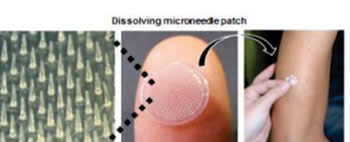Japanese Researchers Demonstrate Novel Transcutaneous Influenza Vaccination Using a Dissolving Microneedle Patch
By LabMedica International staff writers
Posted on 28 Jul 2015
Vaccination via a biodegradable microneedle patch was shown to generate immune response to various strains of the influenza virus that were equal to or stronger than those induced by traditional hypodermic needle injection.Posted on 28 Jul 2015
Previous attempts using microneedles made of silicon or metal were not successful primarily due to the risk of the needles breaking off in the skin, leaving tiny fragments behind. To avoid this problem, investigators at Osaka University (Japan) prepared microneedle patches from hyaluronic acid, a naturally occurring and water soluble biological material. The "MicroHyala" microneedle patch was loaded with the material to be injected and then applied like a plaster. The needles pierced the top layer of skin and then dissolved into the body, taking the vaccine with them.
In the current study the investigators examined the clinical safety and efficacy of the MicroHyala vaccination method using MH (flu-MH), which contains trivalent influenza hemagglutinins (15 micrograms each). Subjects were treated transcutaneously (TCI group) with a flu-MH microneedle patch, and were compared with subjects who received subcutaneous injections (SCI group) of a solution containing 15 micrograms of each influenza antigen.
Results published in the July 2015 issue of the journal Biomaterials revealed that no severe local or systemic adverse events were detected in either group. Immune responses against A/H1N1 and A/H3N2 strains were induced equally in the TCI and SCI groups. Moreover, the efficacy of the vaccine against the B strain in the TCI group was stronger than that in the SCI group.
"Our novel transcutaneous vaccination using a dissolving microneedle patch is the only application vaccination system that is readily adaptable for widespread practical use," said senior author Dr. Shinsaku Nakagawa, professor of medical pharmacy at Osaka University. "Because the new patch is so easy to use, we believe it will be particularly effective in supporting vaccination in developing countries."
"We were excited to see that our new microneedle patch is just as effective as the needle-delivered flu vaccines, and in some cases even more effective," said Dr. Nakagawa. "We have shown that the patch is safe and that it works well. Since it is also painless and very easy for non-trained people to use, we think it could bring about a major change in the way we administer vaccines globally."
Related Links:
Osaka University












 (3) (1).png)


